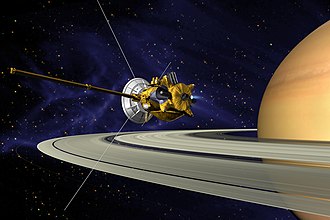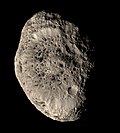Cassini–Huygens
Cassini–Huygens was a space mission, sent to Saturn, the sixth planet from the Sun to study its rings, and its moons.
 Artist's concept of Cassini's orbit insertion around Saturn | |
| Mission type | Cassini: Saturn orbiter Huygens: Titan lander |
|---|---|
| Operator | Cassini: NASA / JPL Huygens: ESA / ASI |
| COSPAR ID | 1997-061A |
| SATCAT no. | 25008 |
| Website | |
| Mission duration |
|
| Spacecraft properties | |
| Manufacturer | Cassini: Jet Propulsion Laboratory Huygens: Thales Alenia Space |
| Launch mass | 5,712 kg (12,593 lb)[1][2] |
| Dry mass | 2,523 kg (5,562 lb)[1] |
| Power | ~885 watts (BOL)[1] ~670 watts (2010)[3] ~663 watts (EOM/2017)[1] |
| Start of mission | |
| Launch date | October 15, 1997, 08:43:00 UTC |
| Rocket | Titan IV(401)B B-33 |
| Launch site | Cape Canaveral SLC-40 |
| End of mission | |
| Disposal | Controlled entry into Saturn |
| Last contact | September 15, 2017
|
| Orbital parameters | |
| Reference system | Kronocentric |
| Flyby of Venus (Gravity assist) | |
| Closest approach | April 26, 1998 |
| Distance | 283 km (176 mi) |
| Flyby of Venus (Gravity assist) | |
| Closest approach | June 24, 1999 |
| Distance | 623 km (387 mi) |
| Flyby of Earth-Moon system (Gravity assist) | |
| Closest approach | August 18, 1999, 03:28 UTC |
| Distance | 1,171 km (728 mi) |
| Flyby of 2685 Masursky (Incidental) | |
| Closest approach | January 23, 2000 |
| Distance | 1,600,000 km (990,000 mi) |
| Flyby of Jupiter (Gravity assist) | |
| Closest approach | December 30, 2000 |
| Distance | 9,852,924 km (6,122,323 mi) |
| Saturn orbiter | |
| Orbital insertion | July 1, 2004, 02:48 UTC |
| Titan lander | |
| Spacecraft component | Huygens |
| Landing date | January 14, 2005 |
The mission was made by NASA, the European Space Agency (ESA), and Italian Space Agency (ASI). The spacecraft had two main parts: the Cassini orbiter and the Huygens probe. It was launched on October 15, 1997 and entered into orbit around Saturn on July 1, 2004. It was the first spacecraft to orbit Saturn and the fourth to visit Saturn (the others were flybys and did not enter orbit). The mission ended September 2017.
Cassini orbiter
The orbiter was named after the Italian-French astronomer Giovanni Domenico Cassini, who discovered some moons of Saturn. Most of the orbiter was designed and built by NASA, although ASI built and programmed some parts that talked to the Huygens probe. The spacecraft spent 13 years in orbit, sending back data. It visited many parts of the Saturn system until it was short of fuel. The Cassini–Huygens ended with a controlled crash into Saturn's atmosphere on September 15, 2017.[5]
Huygens probe
ESA (European Space Agency) made the Huygens probe, named after the Dutch astronomer, mathematician, and physicist Christiaan Huygens who discovered Titan. On December 25 2004, the Huygens probe left the orbiter. A couple weeks later, the probe parachuted onto Saturn's largest moon Titan. Astronomers have wondered what the surface of Titan was like, since it was hidden under thick clouds. It is the only moon in our solar system with a thick atmosphere. The probe descended and sent pictures and other data back for scientists to study. After 90 minutes on the moon, the spacecraft stopped working, as expected. It is the farthest place we have ever landed a spacecraft. The pictures sent while parachuting showed rivers, probably of liquid methane. The surface is much too cold for water.
Cassini–Huygens Media
References
- ↑ 1.0 1.1 1.2 1.3 "Cassini–Huygens: Quick Facts". NASA. Retrieved August 20, 2011.
- ↑ Krebs, Gunter Dirk. "Cassini / Huygens". Gunter's Space Page. Retrieved June 15, 2016.
- ↑ Barber, Todd J. (August 23, 2010). "Insider's Cassini: Power, Propulsion, and Andrew Ging". NASA. Archived from the original on April 2, 2012. Retrieved August 20, 2011.
- ↑ Error on call to Template:Cite interview: Parameter subject (or last) must be specified
- ↑ "The Grand Finale Toolkit". NASA. Retrieved April 15, 2017.
Other websites
- Spacecraft Cassini is Visiting Saturn! — children's stories explaining the Cassini mission
- Cassini-Huygens Main Page at NASA
- Cassini Mission Homepage Archived 2006-04-28 at the Wayback Machine by the Jet Propulsion Laboratory
- Cassini-Huygens Mission Profile Archived 2013-12-16 at the Wayback Machine by NASA's Solar System Exploration
- Cassini Imaging Homepage
- Cassini information by the National Space Science Data Center (NSSDC).
- Photo Gallery - full coverage
- Cassini's Tour de Saturn part A, B, C, D, E, F – descriptions of the 4-year tour of Saturn by Bruce Moomaw
- SpaceflightNow news coverage of the mission Archived 2013-02-03 at the Wayback Machine
- Countdown to Cancel the Cassini Space Probe by the Baltimore Peace Network in 1997 due to concerns over the use of plutonium


